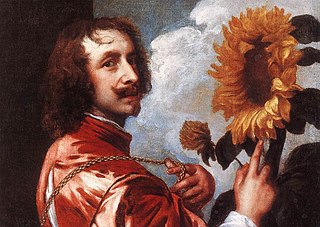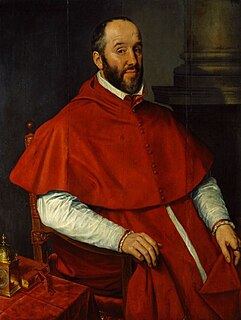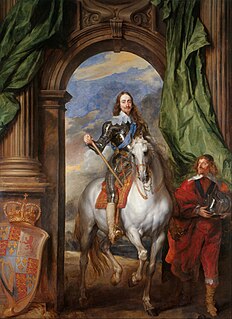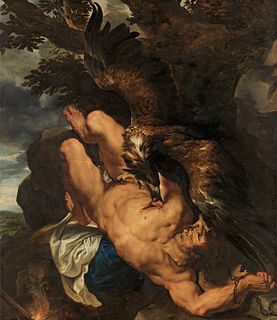
Tiziano Vecelli or Vecellio, known in English as Titian, was an Italian (Venetian) painter during the Renaissance, considered the most important member of the 16th-century Venetian school. He was born in Pieve di Cadore, near Belluno. During his lifetime he was often called da Cadore, 'from Cadore', taken from his native region.

The legend of Saint George and the Dragon tells of Saint George taming and slaying a dragon that demanded human sacrifices. The story goes that the dragon originally extorted tribute from villagers. When they ran out of livestock and trinkets for the dragon, they started giving up a human tribute once a year. This was acceptable to the villagers until a well-loved princess was chosen as the next offering. The saint thereupon rescues the princess chosen as the next offering. The narrative was first set in Cappadocia in the earliest sources of the 11th and 12th centuries, but transferred to Libya in the 13th-century Golden Legend.

Sir Anthony van Dyck was a Flemish Baroque artist who became the leading court painter in England after success in the Southern Netherlands and Italy.

Antoine Perrenot de Granvelle, Comte de La Baume Saint Amour, was a Bisontin statesman, made a cardinal, who followed his father as a leading minister of the Spanish Habsburgs, and was one of the most influential European politicians during the time which immediately followed the appearance of Protestantism in Europe; "the dominating Imperial statesman of the whole century". He was also a notable art collector, the "greatest private collector of his time, the friend and patron of Titian and Leoni and many other artists".
An equestrian statue is a statue of a rider mounted on a horse, from the Latin eques, meaning 'knight', deriving from equus, meaning 'horse'. A statue of a riderless horse is strictly an equine statue. A full-sized equestrian statue is a difficult and expensive object for any culture to produce, and figures have typically been portraits of rulers or, in the Renaissance and more recently, military commanders.

Kehinde Wiley is an American portrait painter based in New York City, who is known for his highly naturalistic paintings of Black people, frequently referencing the work of Old Master paintings. He was commissioned in 2017 to paint a portrait of former President Barack Obama for the Smithsonian National Portrait Gallery, which has portraits of all previous American presidents. The Columbus Museum of Art, which hosted an exhibition of his work in 2007, describes his work as follows: "Wiley has gained recent acclaim for his heroic portraits which address the image and status of young African-American men in contemporary culture."

Napoleon Crossing the Alps is a series of five oil on canvas equestrian portraits of Napoleon Bonaparte painted by the French artist Jacques-Louis David between 1801 and 1805. Initially commissioned by the King of Spain, the composition shows a strongly idealized view of the real crossing that Napoleon and his army made across the Alps through the Great St Bernard Pass in May 1800.

The Royal Collection of the British royal family is the largest private art collection in the world.
Events from the year 1548 in art.

The Palais des Beaux-Arts de Lille is a municipal museum dedicated to fine arts, modern art, and antiquities. It is one of the largest art museums in France.

Sir Peter Paul Rubens was a Flemish artist and diplomat from the Duchy of Brabant in the Southern Netherlands. He is considered the most influential artist of the Flemish Baroque tradition. Rubens's highly charged compositions reference erudite aspects of classical and Christian history. His unique and immensely popular Baroque style emphasized movement, colour, and sensuality, which followed the immediate, dramatic artistic style promoted in the Counter-Reformation. Rubens was a painter producing altarpieces, portraits, landscapes, and history paintings of mythological and allegorical subjects. He was also a prolific designer of cartoons for the Flemish tapestry workshops and of frontispieces for the publishers in Antwerp.

Equestrian Portrait of Charles V is an oil-on-canvas painting by the Italian Renaissance artist Titian. Created between April and September 1548 while Titian was at the imperial court of Augsburg, it is a tribute to Charles V, Holy Roman Emperor, following his victory in the April 1547 Battle of Mühlberg against the Protestant armies.

The Equestrian Portrait of Charles I is a large oil painting on canvas by Anthony van Dyck, showing Charles I on horseback. Charles I had become King of England, Scotland and Ireland in 1625 on the death of his father James I, and Van Dyck became Charles's Principal Painter in Ordinary in 1632.

The Portrait of Charles V is an oil on canvas portrait of Charles V, Holy Roman Emperor by Titian, painted in 1548. As with the Equestrian Portrait of Charles V, it was commissioned by Charles during Titian's stay at the imperial court at Augsburg. It is now in the Alte Pinakothek in Munich, Germany.

The Portrait of Isabella of Portugal is an oil-on-canvas portrait of Isabella of Portugal, Holy Roman Empress by Titian dating to 1548. It was part of the Spanish royal collection and is now in the Museo del Prado in Madrid.

Venus with a Mirror is a painting by Titian, now in the National Gallery of Art in Washington, DC, and it is considered to be one of the collection's highlights.

Charles I with M. de St Antoine is an oil painting on canvas by the Flemish painter Anthony van Dyck, depicting Charles I on horseback, accompanied by his riding master, Pierre Antoine Bourdon, Seigneur de St Antoine.

Prometheus Bound is an oil painting by Peter Paul Rubens, a Flemish Baroque artist from Antwerp. Influenced by the Greek play, Prometheus:The Friend of Man, Peter Paul Rubens completed this painting in his studio with collaboration from Frans Snyders, who rendered the eagle. It remained in his possession from 1612 to 1618, when it was traded in a group of paintings completed by Rubens, to Englishman Sir Dudley Carleton in exchange for his collection of classical statues. This work is currently in the collection of the Philadelphia Museum of Art.
Napoleon Leading the Army over the Alps is an equestrian portrait of a youthful black male painted by the contemporary artist Kehinde Wiley in 2005. It is based on Jacques-Louis David’s 1801 equestrian portrait, Napoleon Crossing the Alps. This painting was chosen by a man who Wiley had approached in the streets. The basic composition of Wiley's painting is the same as the 200-year-old painting it was based on, and has many of the same elements. The modern painting has a decorative background rather than the battlefield background. It is in the Brooklyn Museum.

The Spanish royal collection of art was almost entirely built up by the monarchs of the Habsburg family who ruled Spain from 1516 to 1700, and then the Bourbons. They included a number of kings with a serious interest in the arts, who were patrons of a series of major artists: Charles V and Philip II were patrons of Titian, Philip IV appointed Velázquez as court painter, and Goya had a similar role at the court of Charles IV.

















